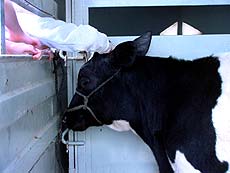|
Features,
Honors
& Awards, Ag
Announcements
Calendar,
Ag News Elsewhere
(fresh daily from the Web)
|
|
Features
|
|
Nuisance fruit removal
By John
Fulton
[MARCH
24, 2003]
One of the main things to
discuss today is the removal of nuisance fruit. You may be thinking
about those apples or peaches, but really the nuisance fruit
category includes things that are much more a nuisance, like sweet
gum balls, maple seeds and crab apples. I used this topic a few
years ago in a column, and then there was a product shortage
locally, but I think that has been taken care of.
|
|
There are several products available to
eliminate nuisance fruit. The most common is ethephon, which is used
as a foliar spray to reduce or eliminate undesirable fruit or seeds.
Some of the trade names include Florel and Ethrel. The product is
effective at eliminating much of the fruit without affecting leaf
growth and color, and it does not harm other plants that get some
spray drift on them. It also does not affect the actual flowering of
the treated trees.
With ethephon, the key is in the
timing. The application must be made during flowering but before the
fruit sets in. For most flowering trees there is a 10- to 14-day
window of opportunity. Sweet gums are a little tricky since there
are no showy flowers involved, so effective sprays should occur just
as new leaves begin to emerge. Sprays should leave leaves wet but
not to the point of dripping. Good coverage of the tree is needed,
so keep in mind the size of the tree when you are weighing this
option.
This product is a growth regulator that
naturally occurs. Its natural production is stimulated by stress, so
make sure you aren't treating a tree that is under stress from
drought, high temperatures, diseases or other environmental
stresses. Treating stressed trees can cause severe injury to the
plant, such as leaf loss or scorching.

[to top of second column in
this article]
|

Lawn care
Normal spring grass seeding times are
March 15 until April 1. Seeding now may or may not have much
success. The key is in the weather. Spring seedings normally don't
have the success of the fall seedings. The worst timing gets new
seeds germinated but then frosted before a root system is
established. The recommended seeding rate for seeding bare ground is
four pounds of seed per 1,000 square feet. For over-seeding existing
grass, use two pounds. This same time period is also a great time to
do core aeration and dethatching
Several people have also asked about
weed control. Most broadleaf products are best put on around May 1,
while most preventive crab grass treatments are best applied just
before seeds germinate (this is based on soil temperature but will
be about the same time as forsythia blooms). Several of the winter
annual weeds, such as chickweed and henbit, are out now, but
concentrate on one item at a time. Seeding would come first, then
crabgrass treatments, then broadleaf treatments.
Master Gardener Walt Ebel
This past
week saw the passing of one of the initial class members of Master
Gardeners in Logan County. Walt Ebel lost his bout with cancer. Walt
was the founder of the Treemendous Tree Contest and also was a true
rosarian. His skills and knowledge will be greatly missed, and our
heartfelt sympathies to Walt's family.
[John
Fulton]
|
|
 |
|
|
County fourth-graders experience
a 'Celebration of Agriculture'
[MARCH
22, 2003]
More than 300 fourth-graders from Logan County visited
the Lincoln Park District Recreation Center Thursday. The
fourth-graders attended a half-day agriculture fair designed to give
the students knowledge of agriculture and its many uses in today's
world. The fair focused on the need people have for agriculture and
its importance in their daily lives. Nearly 100 percent of the
county's fourth-graders participated. Students attended from 13
schools in the county.
|
|
The fair was
sponsored by the Logan County Farm Bureau to coincide with
National Ag Day.
"Many students from
rural areas do not live on working farms," said Lynn Paulus of the
Farm Bureau. "The fair gives students an opportunity to experience
agriculture and the variety of uses farm products have."
Paulus said, "Three
county FFA chapters, from Mount Pulaski, Lincoln and Hartsburg-Emden,
helped present the fair."
The fair consisted of
presentations that were spread out over two half-hours. The
presentations included five breakout stations plus a sheep shearing
demonstration.
The fourth-graders
saw modern farm machinery, tractors, combines and a diesel truck.

"The tractors are
really big," commented Cody Mathis, a fourth-grader from Mount
Pulaski. Joe Rankin and Paul Stolzenburg agreed. All three students
said that they were enjoying the fair and learning a lot.
The Hartsburg-Emden
FFA presented a station that focused on safety and taking safety
precautions around farm machinery.
Another breakout
station was about corn and its many uses. Corn can be used in many
ways, ranging from food products to ethanol fuel to making plastic
and even clothing. A wedding dress was made using corn, and shirts
are made from materials using corn.
The fourth-graders
were very excited about what they did at the corn station. "We made
plastic," Dylan Hughes and Ethan Cline said. Levi Clampet said, "It
looks like burnt cheese." Connor Cruise said, "Mine looks like
blood." The students were obviously enjoying the presentations. They
were very excited about the interactive parts of the "celebration."
Other breakout
stations covered dairy products, hogs and pork products, and
soybeans and soy products.
Drew Olson from the
Hartsburg-Emden FFA helped students make ice cream at the dairy
breakout station. The students then got to enjoy tasting a sample of
their product.


[to top of second column in
this article]
|

John Erwin from
Beason brought his 7-month-old calf named Topper for the students to
meet. He also brought a portable milking machine. The fourth-graders
put their thumbs all the way up the tubing on the machine and
experienced the suction cows feel when they are being milked. This
was one of the fourth-graders' favorite stations.

[photos by Bob Frank]
At the hog and pork
station students sampled sausage, met a pig and learned about
nonedible products made from pork.
Ben Rekart, a
fourth-grader from Lincoln, said, "I learned that buttons can be
made from pork."
Ben also learned
about hog feed. The sample feed consisted of jellybeans that
represented water, M&Ms that represented vitamins, peanuts and
raisins that equaled protein, and candy corn and wheat for
carbohydrates. These nutrients are what hogs need in their food.
The soy products
station included a game of soy bingo featuring soy products as items
on the bingo board. MaryLou Klokkenga of the Emden Farm Bureau
women's committee also presented fourth-graders with samples of
foods made from soy, ranging from soy chocolate milk to soy butter
and soy crackers.

The final
presentation of the agriculture fair was a sheep shearing
demonstration. All of the fourth-graders sat in a circle watching as
a sheep was sheared. There were some "oohs" from the audience as the
shearing progressed. When the sheep was sheared, one fourth-grader
asked, "Does that hurt?"
The fourth-graders
from Logan County all seemed to enjoy the agriculture fair. They
showed a large amount of interest in all of the stations.
The students will now be asked to write
an essay about "The Celebration of Agriculture," which they must
submit by April 1. Students from the Phi Theta Kappa honorary
society at Lincoln College will judge which five essays are the
best. The five winners selected will receive trophies. From the
enthusiasm shown by all of the fourth-graders in attendance
Thursday, judging the essay contest will be very difficult.
[Don
Todd]
|
|
 |
|
|
Weekly outlook
USDA reports
[MARCH
17, 2003]
URBANA -- The large range of
expectations about the stocks and acreage numbers to be released in
USDA reports on March 31 opens the door for some surprises,
according to a University of Illinois Extension marketing
specialist.
|
|
"Add in the wide range of expectations
about 2003 growing conditions, the generally low level of
inventories and an uncertain export picture, and a case for volatile
prices can be made," said Darrel Good. "The uncertainty during the
spring and summer months typically offers some attractive pricing
alternatives for producers. Hopefully, that will be the case again
this year."
Good's comments came as he reviewed the
upcoming USDA reports. On March 31, USDA will release the results of
the spring planting intentions survey and the March 1 report on
grain stocks. These reports will provide additional supply-side
information for the corn and soybean markets for the next several
weeks.
"The reports will set the tone for
these markets, much like the January reports set the tone for the
winter markets," said Good. "The January reports featured a
surprising increase in the estimated size of the 2002 soybean crop
and revealed a much slower rate of feed and residual use of corn
during the first quarter of the 2002-03 marketing year.
"Anticipating the estimate of March 1
stocks of corn and soybeans is more difficult than normal this
year."

For soybeans, Good explained, the major
source of confusion is the large discrepancy between the USDA and
Census Bureau export estimates and the resulting large estimate of
"residual" use projected by USDA. Through January, there was a
60-million-bushel difference in the USDA and census estimates of
exports.
In addition, until the February Census
Bureau crush report is released next week, there is some uncertainty
about the magnitude of domestic soybean processing during the second
quarter of the marketing year. The crush was down by only 2.2
percent during the first four months of the marketing year but was
off by 8 percent in January. Where, Good asked, will the February
estimate come in?
"Using the Census Bureau estimate of
exports, a larger than normal estimate of 'residual' use of soybeans
during the first half of this year, and assuming an 8 percent
reduction in the domestic crush in February, March 1 soybean stocks
should have been near 1.2 billion bushels," said Good. "Using the
USDA estimate of exports during the first half of the year and a
normal 'residual' use during the first half of the year, March 1
soybean stocks should have been near 1.175 billion bushels. Both
figures are well below the 1.336 billion bushel inventory of a year
ago, but 25 million bushels one way or another has important price
implications."
[to top of second column in
this article]
|

For corn, there are two sources of
uncertainty surrounding the projection of March 1 stocks. The first
is the difference in the export estimates among the various sources.
Through January, the Census Bureau estimate of cumulative corn
exports totaled 668 million bushels. The USDA export inspection
report showed shipments of 636 million bushels and the USDA report
on export sales showed shipments of 672 million bushels.
"Since the USDA uses the Census Bureau
estimate as the official estimate, the USDA has to account for the
difference in making the projection of feed and residual use of
corn," said Good. "In addition, expectations about feed and residual
use of corn during the second quarter of the marketing year are
clouded by the large amount of feed byproducts produced by the
ethanol industry. The byproduct substitutes for both grain and
protein feed in the livestock ration.
"Our calculations would suggest a March
1, 2003, inventory of corn near 5.2 billion bushels, compared to 5.8
billion on the same date last year."
The early projections from the private
sector indicate expectations of about 80.6 million acres of corn
planted in 2003. That represents an increase of about 1.55 million
acres from planted acreage in 2002. Under normal conditions, planted
acreage of that magnitude would result in acreage harvested for
grain near 73.6 million acres, about 4.3 million more than the
weather-reduced acreage of 2002.
"There is a wide range in private
sector expectations about intentions for soybean acreage in 2003,"
said Good. "Projections are in a range of 69.8 to 72.9 million,
compared to 73.758 million planted in 2002. The difference appears
to reflect expectations about spring wheat acreage and about total
planted acreage of major crops.
"At least
one popular private source expects combined acreage of corn,
soybeans and wheat to increase by 2.25 million acres in 2003, even
with a 1.1-million-acre decline in spring wheat seedings."


[U
of I news release]
|
|
 |
|
|
Farmers could see a
break in
seasonal use vehicle registration
[MARCH
17, 2003]
Farmers could save hundreds
of dollars each year under legislation sponsored by Sen. Bill Brady,
44th District, that allows special vehicle registration plates for
farm trucks and trailers strictly for the months those vehicles are
used for planting and harvest.
|
|
Approved by the
Senate Agriculture and Conservation Committee March 11, Senate Bill
1471 allows the owners of farm trucks and trailers to purchase
registration stickers for four-month periods -- July through
October, November through February and March through June. For each
four-month period, the owners would only pay one-third the usual
12-month registration fee.
Former Gov. George
Ryan's Illinois FIRST Program increased all truck and trailer
registration fees by 25 percent. Many farm vehicles are only used
seasonally -- for planting or harvest -- so their owners should not
be required to pay the 12-month registration fee. With a tough
economy and so many farmers struggling, this legislation makes
sense.
Under current law,
the registration fees and taxes imposed on farm trucks and farm
trailers cannot be reduced or prorated.

[to top of second column in
this article]
|

A farm truck is any
truck used exclusively for the owner's own agriculture,
horticultural or livestock raising operations, or any truck used
only in the transportation of seasonal, fresh, perishable fruit or
vegetables from farm to the point of first processing. These
vehicles may be registered by paying a $10 registration fee and a
highway use tax based on truck and load weight. The amounts can
range from $150 to nearly $1,500 per year.
A farm trailer
(determined by guidelines similar to those defining a farm truck)
may be registered by paying a $10 registration fee and a highway use
tax based on trailer and load weight. The amounts can range from $60
to $650 per year.
What is suggested is
that a farm truck or trailer may, at the owner's option, be
registered for a period of four months at a time, at a cost of
one-third of the applicable yearly registration fee. The secretary
of state would provide a distinctive decal for each four-month
period, and the vehicle owner would simply affix the decal to the
vehicle's license plate.
Senate Bill 1471 now moves to the full
Senate for further consideration.
[News release]
|
|
 |
|
|
Honors
& Awards
|
|
Hartem
FFA has three district winners
|
|
[MARCH
17, 2003]
Three
Hartsburg-Emden FFA members were named District 3 winners at the
district interviews for their record-keeping project areas. Winners
were Krista Ubbenga, Natalie Coers and Matthew Wrage. These FFA
members now advance to Champaign on April 5 to determine the state
winner.
Other Hartem
FFA members who did not advance past district were Shane Westen
(came in second), Nic Alberts, Kory Leesman and Kyle Hoerbert.
[Hartsburg-Emden FFA news
release] |

[courtesy of Hartem FFA]
Hartem FFA members (left to right) Kyle Hoerbert, Krista Ubbenga,
Shane Westen, Matt Wrage, Natalie Coers, Kory Leesman and Nic
Alberts |
|
|
Ag
Announcements
|
|
Heartland Beef Alliance to
meet
|
|
[MARCH
24, 2003]
The
next meeting of the Heartland Beef Alliance will be March 29 in the
Illini Central High School agriculture classroom, beginning at 7
p.m. Dr. Bill Armbruster will be present to update beef producers on
health concerns. All beef producers in Logan, Mason, Tazewell
counties are welcome to attend.
[Betsy Pech,
secretary] |
 |
|
|
|